Last Updated on: February 5, 2025
Did you know that there are over 500 recorded bird species in Ontario? If you’re a beginner birder, that number can be overwhelming.
So…
The best place to start your birding journey is from the comfort of your own home. Therefore, we prepared a comprehensive guide on ten common birds you can see in your backyard.
We even included tips on attracting these feathered fellows and other exciting information that will make you appreciate them more!
10 Common Backyard Birds Of Ontario
1. American Crow (Corvus brachyrhynchos)
If you’re a horror fan, then you’re probably already familiar with the American Crow. This bird is a staple in many horror movies, video games, and other media due to its ominous, all-black plumage. It’s important to remember that ravens are larger and heavier than crows. However, it may be challenging to differentiate them at first glance.
It’s pretty common to confuse this crow with its close relative, the Common Raven (see image below).
Compared to many other birds, American Crows are known for being very intelligent. Their population continues to thrive because they can adapt to human civilization, despite people’s attempts to exterminate them in the past.
However, they’re only found throughout Ontario during their breeding season, though some are present year-round in southeastern areas like Ottawa and Toronto. That said, you can find them in fields, open forests, shores, and various places around people. They’re also highly social, so you’ll likely find them in large groups.
Besides being intelligent, American Crows are opportunistic feeders. They’ll eat almost anything and can quickly take advantage of new food sources.
For example, they can go from eating seeds to animals hit by cars. Additionally, their feeding behavior can be helpful because they unconsciously disperse seeds and help carcasses decay.
Although they don’t regularly use bird feeders, you may attract them with items like trash, compost, leftover pet food, and peanuts scattered on the ground. However, many consider them pests because they’re loud and aggressive, often scaring other backyard birds.
No matter your opinion of them, we recommend being gentle with crows because they can recognize humans and hold grudges against people they hate.
2. American Goldfinch (Spinus tristis)
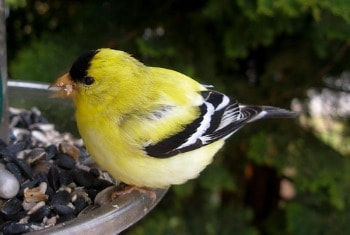

The American Goldfinch is a small bird that appears differently throughout the year. During breeding seasons, males have a bright yellow body, a black cap, and white-streaked wings. Females have the same patterns but are dull yellow instead.
During non-breeding seasons, both sexes appear in a pale, olive-brown color with a yellow patch on the head, as you can see below:
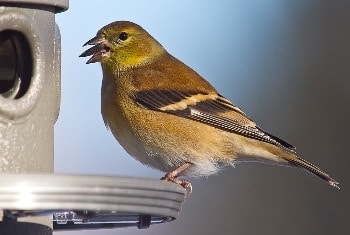
American Goldfinches are widespread in North America. They’re year-round residents in Ontario’s southern regions, although some move further north during breeding seasons.
They are mainly found in semi-open areas with weedy grounds, especially where thistles and asters are common.
They also prefer places with some trees and bushes for nesting and shelter, including forest edges, roadsides, orchards, and suburbs. You’ll often see them flocking with Pine Siskins and Common Redpolls, except during breeding seasons.
American Goldfinches are one of the strictest vegetarians in the bird world. They primarily eat seeds, especially those from weeds and grasses.
Other parts of their diet are bark from young twigs, buds, maple sap, and the occasional insect. You can see their acrobatic display as they climb on plants to forage for seeds.
Even though goldfinch nests are parasitized by Brown-Headed Cowbirds, the cowbird chicks don’t live longer than three days because they can’t survive the seed diet of goldfinches.
They will also visit your bird feeder for nyjer and sunflower seeds, especially during winter. We recommend using a feeder designed for small birds, as large birds could discourage these goldfinches.
You can attract them further by having native composite plants in your backyard, such as thistles.
3. Baltimore Oriole (Icterus galbula)
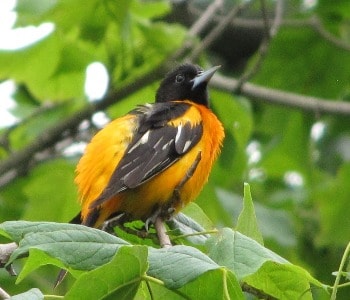
The Baltimore Oriole is one of the flashier birds you’ll see because it looks like a torch. Males have bright orange underparts, shoulders, and rump, while the rest of their body is black. Their wings have multiple white stripes as well.
Meanwhile, females are bright yellow instead of orange, and their wings are brown with white stripes.
Their patterns also vary – some females have an all-yellow head while others have brown spots, which you can see below:
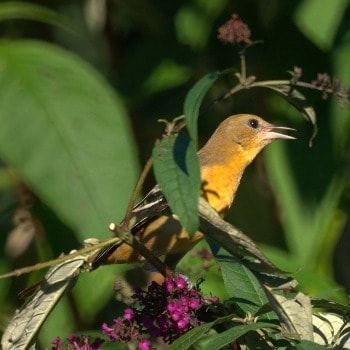
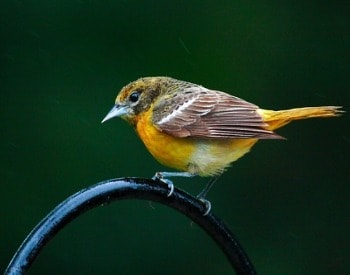
Females become more orange as they molt, eventually almost as bright orange as males.
Baltimore Orioles are mainly found in southern Ontario during breeding seasons. You can find them in mixed and deciduous forests, usually around edges and open areas instead of the forest interior. They’re also in parks, towns, and backyards with deciduous trees.
They usually eat many insects during summer, especially caterpillars. They even eat the hairy ones that many birds avoid. This is crucial in their ecosystem because the caterpillars they eat are harmful to plants.
Other parts of their diet include berries, flowers, fruits, nectar, and snails. Finding them in the wild may be challenging as they often feed high up on trees, so you’ll need some patience to see them lower down.
Unlike other fruit-eating birds, Baltimore Orioles seek dark-colored fruits and often ignore fruits like yellow cherries and green grapes, even if they’re ripe.
You can easily attract Baltimore Orioles by cutting ripe oranges in half and hanging them around trees. Alternatively, you can install an oriole feeder containing fruits and sugar water. You can also plant fruit-bearing trees and nectar-bearing flowers in your backyard.
4. Black-Capped Chickadee (Poecile atricapillus)

The Black-Capped Chickadee is a tiny bird with a large head. It has black legs, buff underparts, a light gray back, and dark gray wings and tail, both having white edges.
However, the bird is known for its (you guessed it) black cap, accompanied by a black bib and white cheeks.
Black-Capped Chickadees are common year-round in Ontario, except for its northern regions. You can find them in open deciduous and mixed forests, especially those with birch and alder trees. They also thrive in neighborhoods and parks with enough trees and shrubs.
These small birds are social and tend to flock with other species. Specifically, migrating songbirds that find themselves in unfamiliar areas often associate with chickadee flocks.
If you’re an avid birder, you might find some exciting migrants if you look for chickadee flocks during fall and winter!
These chickadees even have a hierarchy within their flocks, where dominant birds mate with each other and access better resources.
Additionally, they allow brain cells with old information to die during autumn. These are replaced with new brain cells that help them adapt to changes in their environment and social flocks.
Black-Capped Chickadees primarily consume insects during summer, especially caterpillars. However, they feed more on seeds and berries during winter. They would often store food for later, and they’re good at remembering each of these hiding places.
Due to their curiosity, this species is one of Ontario’s most common backyard birds. You can easily attract them with suet, peanuts, and sunflower seeds.
Sometimes, they may even eat from your hands (see image below). You can also attract a breeding pair by installing nest boxes or planting birch, alder, or willow trees.
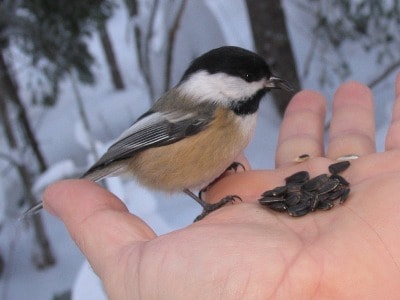
5. Blue Jay (Cyanocitta cristata)
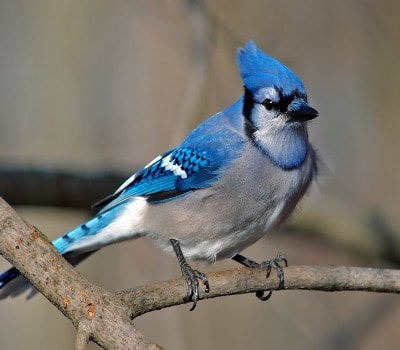
The Blue Jay is one species you’ll instantly recognize, unlike many other birds. It has white underparts, while its back and crest are blue.
There are also black streaks on its face, surrounding its black bill and eyes. Meanwhile, the main attractions are its tail and wings, which have an assortment of blue, white, and black bars.
By the way, did you know that a Blue Jay isn’t blue because of pigments? Instead, the structure of their feathers reflects light in a way that makes them appear blue.
If you were to crush a Blue Jay’s feathers, the blue color would disappear because you destroyed the structure.
That said, Blue Jays are present in Ontario year-round, mainly in the southern half of the province.
You can find them around deciduous and mixed woods, but they’re also common in well-wooded parks, suburbs, and towns. It’s also easy to notice them because they’re usually loud and make various sounds.
One of these sounds is a bird call imitation from a Red-Shouldered Hawk (see image below). They use this call to alert other jays that a hawk is present or to deceive other birds into thinking a predator is around. That’s quite a smart move to take all the food for yourself!
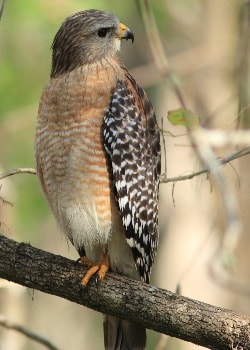
Speaking of smart, Blue Jays are also known for their intelligence – for example; captive jays have been observed to use newspaper strips to rake in food from outside their cages.
Meanwhile, they’re omnivorous but favor vegetable matter, including nuts, seeds, berries, and fruits. They’re one of the only birds that can open nuts with their beak.
You can attract Blue Jays with suet, sunflower seeds, and peanuts. They also prefer bird feeders on a post over hanging feeders.
6. Downy Woodpecker (Dryobates pubescens)
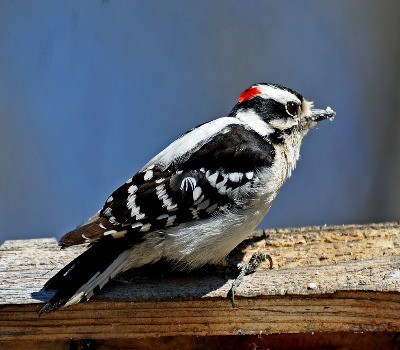
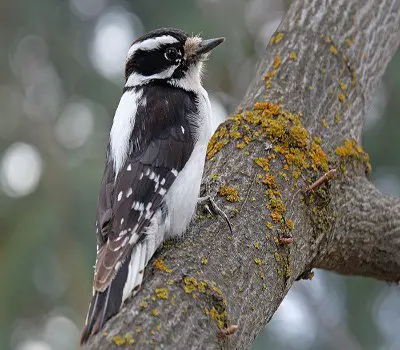
The Downy Woodpecker is black-and-white overall – it has white underparts and back, a boldly-striped head, black wings with white markings, and a black tail with white outer tail feathers.
If you look closely, you can distinguish both sexes. Specifically, the male has a red patch on the head, whereas the female doesn’t. However, this bird has an almost identical plumage to the Hairy Woodpecker (see image below).
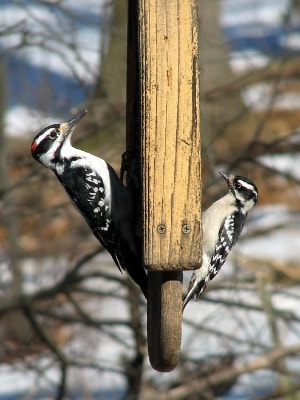
Downy Woodpeckers are common birds in Ontario year-round, except for the province’s northern regions.
These birds favor various habitats with deciduous trees, such as open woodlands, groves, orchards, suburban backyards, and city parks. You may also see them flocking with other birds like nuthatches and chickadees.
They nest in a cavity excavated in a dead branch or tree, which they will fiercely defend from intruders. Once the nest is abandoned, it’s used by other cavity-nesting animals.
Downy Woodpeckers primarily eat insects, especially ants and beetles that they pick at the bark surface. They may also eat seeds and berries.
These woodpeckers are more acrobatic than others due to their small size, allowing them to forage in smaller areas like twigs, shrubs, weed stalks, and minor tree branches.
They’re also familiar visitors of bird feeders, especially those that offer suet and shelled peanuts. Sometimes, you may also see them drinking from oriole and hummingbird feeders.
7. House Sparrow (Passer domesticus)
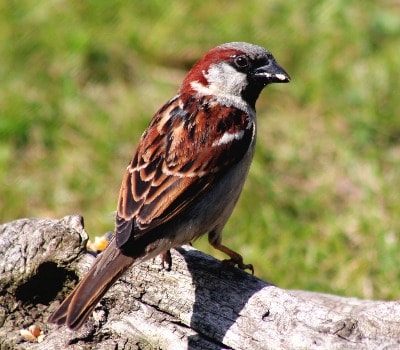
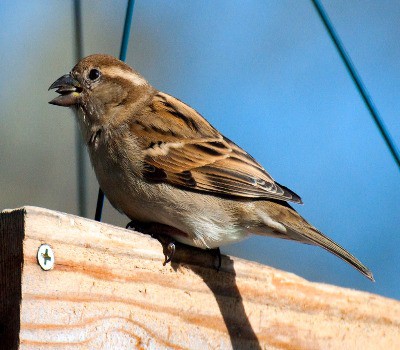
The House Sparrow isn’t as flashy as the other birds in this list because it’s predominantly brown. Males have gray underparts, while their upperparts have bold brown streaks. They also have a black throat, black bill, and a gray cap atop their deep, brown head.
Meanwhile, females have considerably lighter upperparts. They also have a brown cap and a yellow bill, and they don’t have a distinctly-colored throat.
House Sparrows are common birds with a wide distribution throughout North America. They’re present year-round in Ontario, except for its northernmost regions.
As the name suggests, you can find them around houses, buildings, and other manmade structures, but never in undisturbed natural habitats.
They have been around humans for centuries, so they’re unbothered by our presence. They’re also highly social and noisy, so you can easily find flocks by looking around your neighborhood. Due to these qualities, House Sparrows have been used in many avian biological studies.
Their abundance also means they’re a crucial food source for raptors, dogs, cats, and other predators in residential areas. Meanwhile, House Sparrows primarily consume seeds. They usually forage on the ground for grass and weed seeds, although they eat some insects during summer.
In highly urbanized areas, they will take leftovers from humans. They do this in various ways, such as gathering in front of restaurants.
They’re also attracted to a bird feeder containing millet, sunflower seeds, and corn. However, we don’t recommend feeding them since they’re an invasive species. These sparrows have affected some native birds because they compete for food and nesting sites.
If you want to discourage them from your feeder, you can try adding more thistle seeds, nectar, suet, or whole peanuts. However, they will probably still stick around your backyard even if you don’t feed them.
8. Mourning Dove (Zenaida macroura)

The Mourning Dove is a plump bird with a long tail and small head. It has pale brown underparts and gray-brown upperparts. Some of its other features are the blue eye ring, black eyes, pink feet, the black markings on its wings, and the white tip on its tail.
People often confuse the Mourning Dove with the White-Winged Dove (see below) since they have many similar features. If you look at them closely, you’ll notice that the White-Winged species has orange eyes, a white wing bar, and no black colors on the wings.
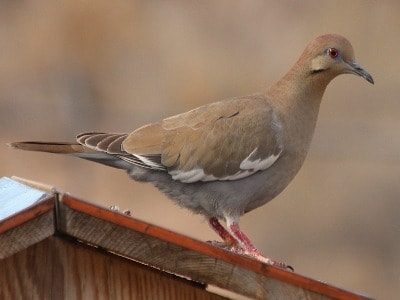
Mourning Doves are common in southern Ontario year-round, although some migrate further north during breeding seasons. Even though they’re popular game birds in North America, these doves are still very abundant.
They typically flock in many open spaces like woodland edges and fields. Additionally, they thrive around manmade habitats, including roadsides, farmlands, suburbs, and telephone wires. Their usual nesting spots are in trees, bushes, buildings, and other structures.
You’ll often see Mourning Doves foraging on the ground for seeds. Seeds make up almost their entire diet, including those of grass, weeds, and cultivated grains.
However, they occasionally eat snails and insects. They usually swallow and store many seeds in their crop, which they digest while resting on a safe perch. Meanwhile, they feed their children “pigeon milk,” a substance they secrete that’s rich in fat and protein.
You can best attract them by scattering seeds, especially millet, on the ground or in under-elevated bird feeders.
They’ll also be encouraged to nest in your backyard if you plant some dense shrubs. However, we recommend keeping your cats indoors because ground-feeding birds are more prone to prowling cats.
9. Northern Cardinal (Cardinalis cardinalis)

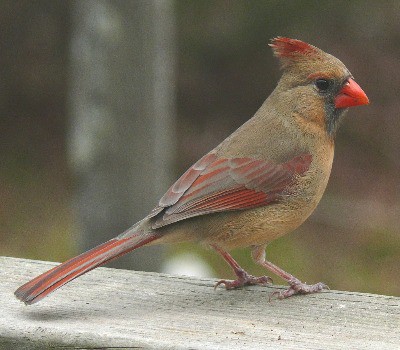
The Northern Cardinal is one of the birds that can instantly catch your attention. The male is flashy with its bright red body, prominent crest, and a black mask that wraps its thick, red bill. Though the female is considerably duller, it can still be easily recognized from the red accents on its brown crown, wings, and tail.
The female cardinal may be confused for a Pyrrhuloxia (see image below) but remember that the latter has a yellow bill.

Northern Cardinals are abundant year-round, but only in the southeastern parts of Ontario. They’re usually around brushy habitats, such as forest edges, thickets, suburban gardens, and city parks.
You can find them easily in winter as their colors brighten the white, snowy background. They also form large flocks during this time. However, you might witness one of their most peculiar behaviors during the breeding season in spring and summer.
Specifically, both sexes often spend hours attacking their own reflection in an attempt to “defend” their territory from intruders.
Moving on, a Northern Cardinal primarily eats vegetable matter, such as seeds, berries, flowers, and wild fruits. They also feed on insects, such as beetles, grasshoppers, ants, and many others. You’ll usually see a pair foraging on the ground or low in bushes.
Since cardinals eat seeds and fruits, they help disperse the seeds of some plants. They also help the population of Brown-Headed Cowbirds, as they sometimes raise the chicks from eggs laid by these brood parasites.
Finally, you can attract them with most bird feeders and birdseed, although they favor sunflower seeds. If there’s undergrowth around your backyard, you may encourage a breeding pair to nest on your property.
10. White-Breasted Nuthatch (Sitta carolinensis)
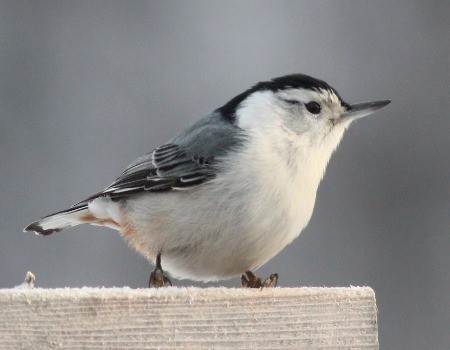
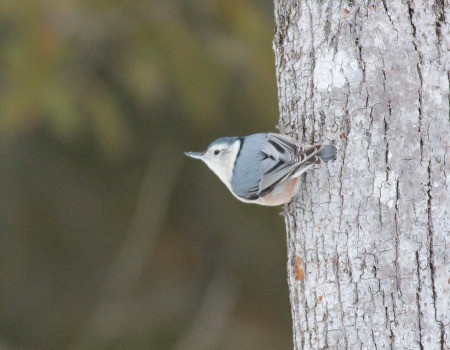
Apart from its white breast, the White-Breasted Nuthatch has a white belly and face. Looking closely, you may also see some rust-brown under the tail. Meanwhile, its upperparts are blue-gray with black-streaked wings and tail.
Both sexes almost look identical, except for a few minor details. The male has a black crown and a faint black eye line, whereas the female has a blue-gray crown and no eye line.
The White-Breasted Nuthatch is common year-round throughout most of the USA, but only in a few places in Canada. Specifically, you can find this species in Ontario’s southern regions.
You can frequently find them around mature deciduous and mixed forests but rarely in purely coniferous forests. They’re also present around suburban areas, cemeteries, and parks, so long as there are large trees. They usually nest in natural cavities or old woodpecker holes.
During winter, you may see these nuthatches joining flocks led by chickadees or titmice, as the strength in numbers helps them forage efficiently and watch for predators.
Speaking of forage, their diet comprises mainly seeds and insects. The proportion of these items differs with seasons, where they eat almost 0% seeds during summer but over 60% during winter.
You’ll usually see them foraging around trunks and large branches, turning their body sideways and upside-down on vertical surfaces.
They’ll also readily visit bird feeders, especially if you offer sunflower seeds, peanuts, and suet. You can even install a nest box before the breeding season to attract a breeding pair. Always remember to adequately protect your nest box to prevent predators from raiding the nest.
Suppose you notice a White-Breasted Nuthatch making multiple trips to your feeder. In that case, it’s probably storing the excess food in tree bark for later consumption!
Watch This!
Frequently Asked Questions
What is the provincial bird of Ontario?
The Common Loon became the official bird of Ontario on June 23, 1994. It appears on the Canadian one-dollar coin, widely known as the “loonie.”
What bird has a yellow belly in Ontario?
Apart from the American Goldfinch and female Baltimore Oriole, some of the other Ontario birds with yellow bellies are:
- Blue-Winged Warbler
- Canada Warbler
- Cape May Warbler
- Cedar Waxwing
- Eastern Meadowlark
- Evening Grosbeak
- Hooded Warbler
- Magnolia Warbler
- Nashville Warbler
- Orange-Crowned Warbler
- Orchard Oriole (female)
- Palm Warbler
- Prairie Warbler
- Prothonotary Warbler
- Scarlet Tanager (female)
- Western Kingbird
- Western Meadowlark
- Wilson’s Warbler
- Yellow Warbler
Are there hummingbirds in Ontario?
Yes. Ruby-Throated Hummingbirds are the only species that regularly occur in Ontario. They visit the southern parts of the province during the breeding season. You can recognize them with their signature bright red throat.
Conclusion
Now that you made it to the end, we hope this article helped you locate, identify, and attract these Ontario birds. Having them around your home is undoubtedly an opportunity you don’t want to miss!
Although these species are abundant, we should still try to protect them because they contribute to our ecosystem one way or another – many birds help disperse seeds, others control insect populations, and some create shelter for other animals.
That said, these are only ten birds you can find in Ontario. We encourage you to go out there and see what nature brings you!

